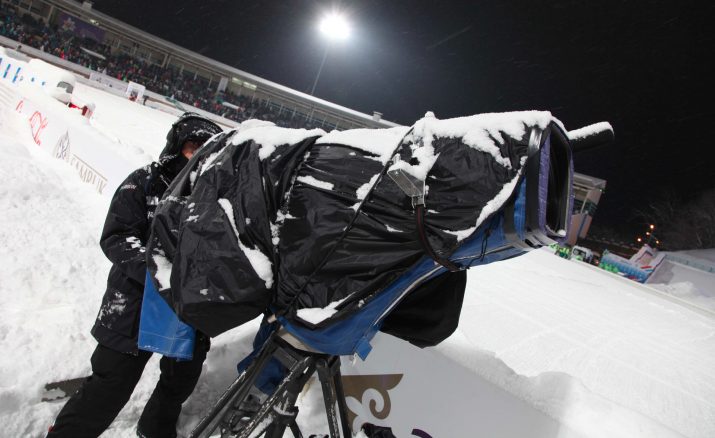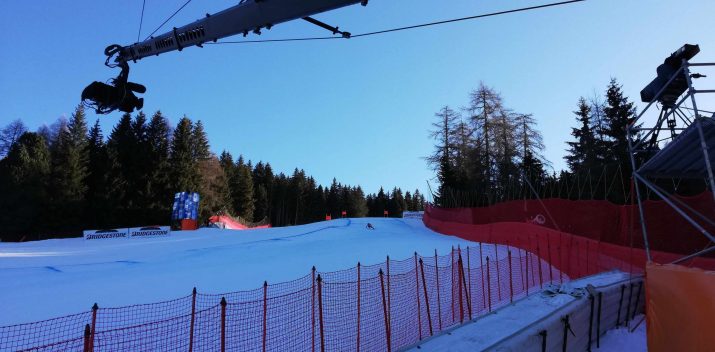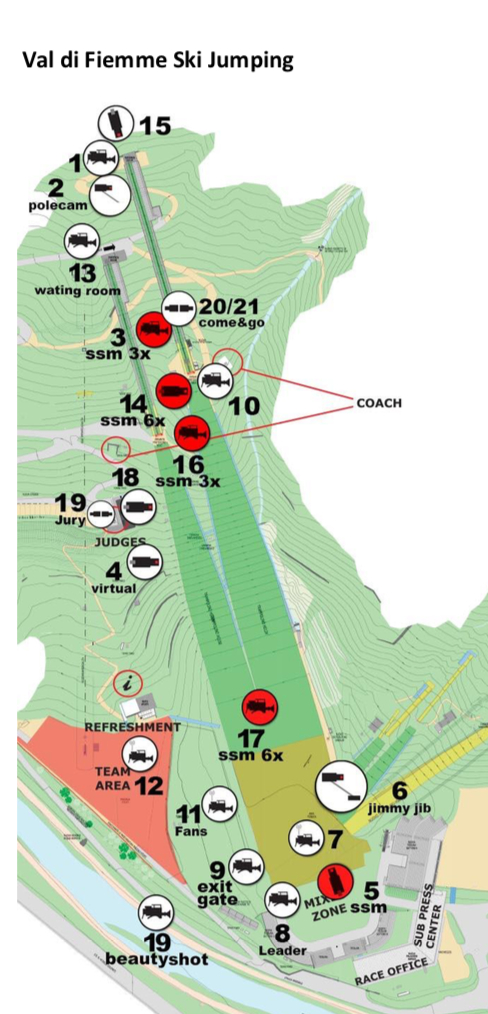Euro Media Group Italy provides broadcast production services for 2019-20 Ski World Cup season

The 2019-2020 season of the Ski World Cup opened at the beginning of November with Skipass, the Fair of Tourism and Winter Sports at ModenaFiere. In this and all other events included in the World Cup calendar, the television production is provided by Euro Media Group (EMG) Italy and its subsidiary Global Production.
The two professionals orchestrating the coverage of these events are executive producers Flavio Baggio and Moreno Roncon. With many years experience in ski TV production, they are a reference point for the producer, Infront, and the local organisers of the various stages of the different International Ski Federation (FIS) disciplines which includes Alpine, Cross-Country, Freestyle, Snowboarding, Ski Jumping and the Nordic Combined.
Baggio said, “this season we also have the good fortune to produce the television coverage of winter sporting events with a very different nature that allows us to field various intertwined production capacities. Events like the one in Modena are held in particular spaces such as fairs and expos that generate a large turnout.”
Roncon added, “after this first test the Ski World Cup in Italy continues on 13 December with the Snowboard race in Cortina. At the same time, Global Production is involved in the preparation of the Super G and Downhill race in Val Gardena, in addition to the Giant Slalom and Parallel Slalom in Val Badia – and at the same time, there is a Snowboard competition in Cervinia. So, there are many concurrent or close-up events adding up to a really extensive and challenging production tour.”
This season many eyes have been focused on the production of Nordic Skiing and on the Val Di Fiemme race, the historic Tour de Ski known as the ‘Final Climb’, in which the athletes run uphill through a gruelling alpine ski slope. The production commitment is enormous and the producer remains Infront Italy, directed by Luigi Catalfano and the technical service is provided by Global Production, which here deploys its OB6 mobile van.

As many as 20 cameras are used along the route and by virtue of the new format – involving a ‘mass start’ – the production also makes use of a helicopter equipped with Cineflex and a snowmobile ski-doo with Steadicam and its radio link that covers part of the route.
This event took place on 3-5 January and in close succession, the production commitment continues with another OB-van engaged in Dobbiaco, OB9, managing 25 cameras. Here, different wireless technologies have been used with radio cameras mounted on sled bikes and others using links connecting on existing infrastructure in LTE 4G. The ‘backpacks’ used for the first time in a production of the World Cup ensure the connection of a camera that moves on a sled motorcycle.
All television events produced are aired worldwide, while in Italy the two broadcasters involved are RAI and Eurosport. The production for these events realises feeds as host broadcaster and also the Italian customisation.
After the Final Climb and still, in the Val di Fiemme with the same mobile OB6 vehicle, the Nordic Combined is scheduled. Here the athletes make the jump from the trampoline and, based on the results, make an ‘interval’ start on a cross country track.
Given the double location of the events, in addition to the mobile vehicle, remote production is also engaged which is composed of a technological core positioned in the compound TV near the jump from the Predazzo trampoline.
A link via non-terminated fibre optic from Trentino Network reaches 22 km away, to Tesero, where a container filled with Grass Valley and Riedel technology enables all the cross country race production. The director, the video mixer and the sound engineer are physically inside the mobile vehicle in Predazzo, while in Tesero there are ‘only’ 25 camera operators.
This means that a mobile vehicle and a container are sufficient to handle a double production. Inside the OB van, two distinct production areas, ‘main’ and ‘secondary’ – with related video mixers and audio mixers – are dedicated to the Trampoline Jump and Cross Country.
The Combined and the Trampoline
Simultaneously with this Nordic Combined, a Trampoline World Cup race is held, again in Val di Fiemme, deploying as many as 25 Grass Valley cameras. Among these, the production lines up six Super Slow Motion, three Super Slow Motion 3X and three Hyper Slow Motion 6X.
 After the Ski Jumping and the Nordic Combined, the production involves another three mobile vehicles and moves to Sestriere where it faces a Women’s Super G race and at the same time other production facilities work at Seiseralm for a Freestyle border cross race and in Piancavallo for a Snowboard race, over a period of about two weeks, from 14 to 26 January.
After the Ski Jumping and the Nordic Combined, the production involves another three mobile vehicles and moves to Sestriere where it faces a Women’s Super G race and at the same time other production facilities work at Seiseralm for a Freestyle border cross race and in Piancavallo for a Snowboard race, over a period of about two weeks, from 14 to 26 January.
Baggio continued, “the season closes with the Marcialonga of Val di Fiemme on 26 January and with a final production that engages us a little more in terms of quality, namely the Women’s Super G in La Thuile in Val D’Aosta, which will be filmed entirely in 4K UHD on 29 February.
“In terms of technical innovation, for the first time in Val Badia and for the filming of the Giant Slalom and Parallel Slalom, a Robycam is engaged. For the former, it covers the last six seconds of the race for about 400 metres and for the latter it goes from the start line to the finish line.”
Roncon concluded, “in the week that sees events being concentrated in Val Gardena, Val Badia, Cervinia and Cortina, we employ 110 technicians at the same time, and in the following week with Val di Fiemme and Dobbiaco, we deploy over 100 professionals.
“For the production of La Thuile in 4K, a mobile vehicle of parent company Euro Media Group Europe – OB1 from VideoHouse Belgium – will join our productive forces, since Global OB8 4K will be involved in the Juventus-Inter football match. During one of these races, 3D immersive audio is used with a Klang processor that is being tested for audio 8 + 1.”
The FIS Ski World Cup season continues until April 2020
